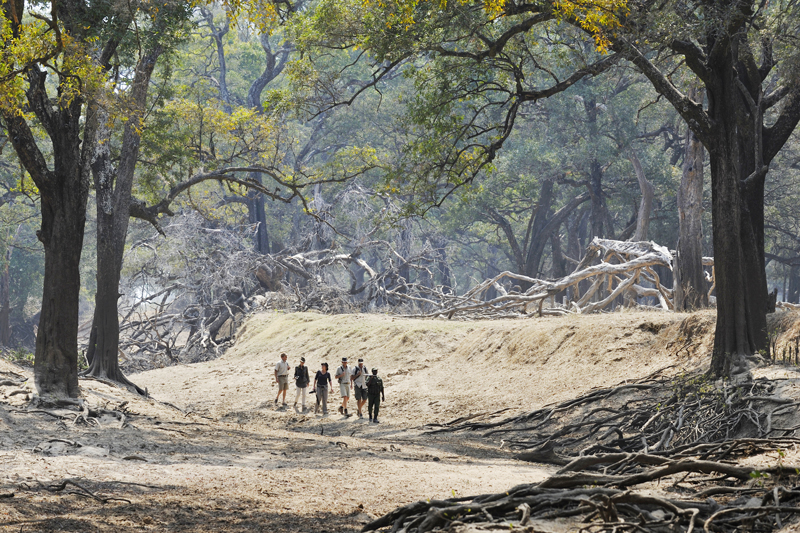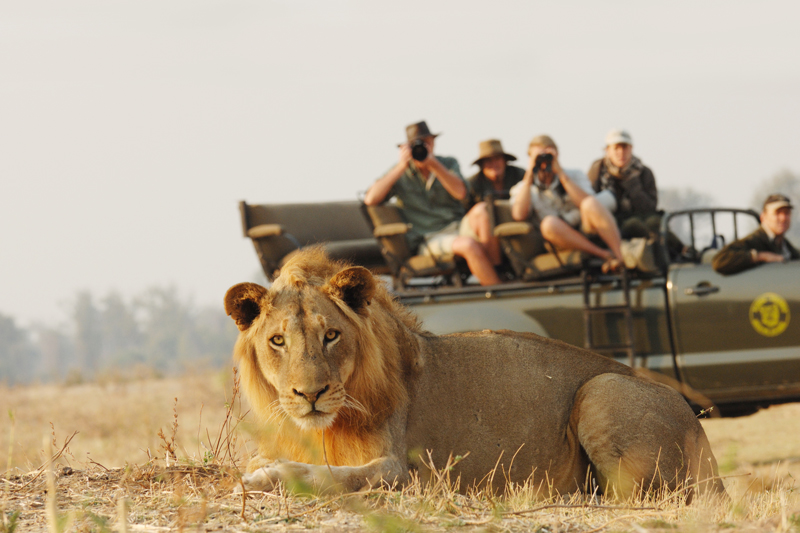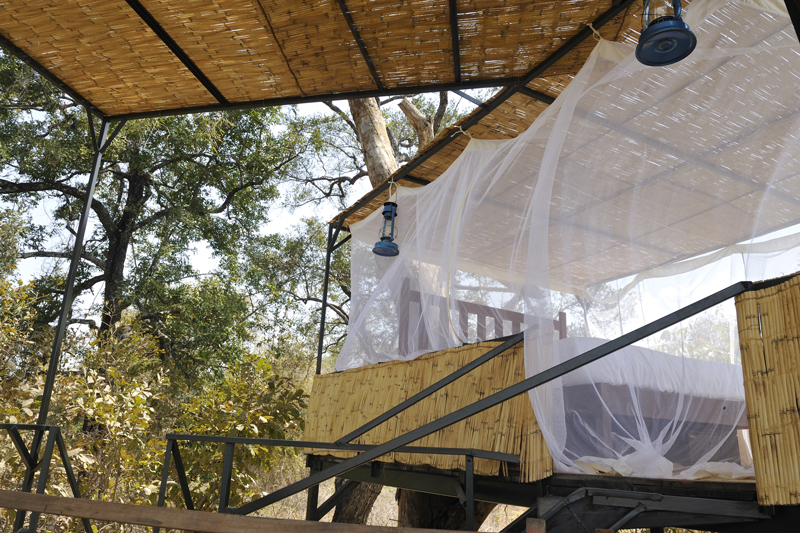Kaingo Camp
Kaingo Camp is an established safari lodge nestled along the steep banks of the Luangwa River in the heart of the South Luangwa National Park.
Kaingo Camp has been the flagship lodge of family owned Shenton Safaris for over 20 years, and whilst not technically owner-hosted these days, it still very much has the feel of an individually owned and managed property. The location is fantastic, arguably about as good as you could get in the South Luangwa for game viewing, and Shenton Safaris have built up an excellent team of guides. Photography has always been a passion at Kaingo, and their various viewing hides allow guests to get very close to the wildlife. The accommodation has recently been refurbished to a very comfortable standard, and the food and service is excellent. However, Kaingo is best suited to guests who are really focused on the game viewing experience, photography and an authentic bush experience.
Rooms
Kaingo Camp offers accommodation for a maximum of 16 guests is in six comfortable stone and thatch chalets (with windows and sliding doors to the front covered in mosquito gauze only). The chalets are comfortably furnished with king size beds, luggage racks, chairs and a table. For twin or triples sharing, the table and chairs are removed and replaced with a queen size bed (note that this second bed is lower to the ground and smaller than the large king bed). Each chalet has an indoor en suite bathroom with vanity unit, toilet and shower, leading to an outside bathroom area which includes an outdoor bath. To the front of all chalets is a shaded verandah and a few steps away is a small deck on the edge of the Luangwa riverbank with comfortable chairs and footrests where you can relax during the heat of the day.
One of the chalets is known as the ‘First House Suite’ which comes with its own private vehicle, a private butler and the option of dining in your suite (though dining in the main area is also possible). As well as the double en suite bedroom, the First House Suite enjoys a separate lounge which can accommodation additional beds (three comfortably, four at a squeeze) for a family. There is an additional en suite toilet attached to the lounge.
Central Areas
The main areas at Kaingo include a central open-sided bar, lounge and dining area, and a shaded viewing deck cantilevered out over the river where afternoon tea is generally enjoyed.
Facilities
Wi-Fi – Yes
Power for charging – Yes
Swimming pool – No
Habitat & Wildlife
The Luangwa Valley is one of Africa’s most scenic and game-rich National Parks. Forming part of the southern end of the Great Rift Valley, the wide valley floor is about 1,000ft lower than the surrounding plateau and through the centre flows the Luangwa River which is fed by dozens of sand rivers during the rainy season, causing it to become a raging torrent. It frequently alters its course from season to season, causing many ox-bow lakes to form. These lakes are very important to the ecology of the valley and account for the high carrying capacity of the park.
Elephant, although slightly smaller than their southern African savannah counterparts, are plentiful, as are buffalo (in huge herds), kudu, waterbuck, puku, impala, bushbuck, warthog, and reedbuck. Thornicrofts giraffe (endemic to the region) are commonly seen and the Cookson’s wildebeest can be seen in the northern sector of the park. Along the river hippo can be seen in their hundreds, in the late dry season packed into ever decreasing water pools, whilst huge crocs laze on the many sand banks. However, the park is perhaps best known for its predator populations, in particular lion and leopard, the latter of which are seen regularly by day and at night. Wild dogs have made a good comeback in the park in recent years and are often sighted. Night drives can also be very productive, with nocturnal species such as civet, genet, honey badger, white-tailed mongoose, African wild cat, spotted hyaena and porcupine regularly seen in addition to the many superb leopard sightings.
The birdlife of the Luangwa is equally exceptional, with over half of the total Zambia species (around 700) being recorded here. Commonly sighted species include crowned crane, white-fronted bee-eaters, carmine bee-eaters (which nest in the banks of the river from late August onwards, Lilian’s lovebird, purple-crested turaco, paradise whydah, striped kingfisher and the impressive saddlebill storks. Pel’s fishing are also regularly seen.
Activities
Kaingo aims to offer an in-depth wildlife experience and is well suited to catering for wildlife enthusiasts and keen photographers. Game viewing drives by open four-wheel drive vehicles (day and night) and walks are complimented by numerous wildlife hides set up in strategic positions: the hippo hide overlooks a deep channel of the river with a seasonal extension which has you at eye level with the hippos; the elephant hide built on stilts above a well-used river crossing point (at additional cost, the elephant hide can also be used for overnight sleep-outs); the carmine bee-eater hide is set up each year (usually from mid-August) in a strategic position near the nesting colonies; and the Wild Dog Lagoon Hide overlooks an area with exception birdlife and plains game. The elephant hide can also be used for an overnight sleep-out on the raised platform and overnight camp-outs in the bush are also possible to arrange offering the chance to get back to basics for the night and to sleep out underneath the stars.
Seasons
Kaingo Camp is open from mid-May to early November, though game viewing conditions will be best from July onwards.
Kaingo generally accepts children eight years and above, although children must be 12 years old to join walking safaris. The First House Suite is ideal for families (the minimum age for here is lower than the rest of camp at six years) with enough space to accommodate four children, though one extra bed can also be added to standard chalets. All families with children under 12 years old are required to book a private vehicle (at extra cost if not staying in the First House where a private guide and vehicle are included). The remote location and adventurous nature of a safari in South Luangwa will tend to appeal most to families with older children. There is no swimming pool.
Derek Shenton, owner of Shenton Safaris and Kaingo Camp, is a third generation conservationist and guide and he runs the operations of Shenton Safaris with his wife, Juliet, who is a zoologist and wildlife photographer. Conservation tourism is very much a part of the ethos and operation of the camp.
Derek is on the board of Conservation South Luangwa, an organisation that works with community and conservation partners and is dedicated to protecting South Luangwa, it’s wildlife and habitat through a combination of law enforcement support (anti-poaching), human-wildlife conflict mitigation, veterinary work and community outreach.
Juliet is one of the founding members of Project Luangwa, a charitable organisation formed by a group of safari operators in South Luangwa who use a portion of the proceeds from each guest to help local communities improve their economic prospects whilst at the same time ensuring positive impact on the environment and wildlife. Juliet also began Art for Conservation which sees Shenton Safaris work with local artists to sell their work. A donation 20% of each sale goes into a conservation or community project chosen by the purchaser.
Guests staying at Kaingo Camp contribute to conservation and community projects supported by Shenton Safaris through a nightly levy.
Shenton Safaris also partners with Pack for a Purpose, a non-profit organisation that encourages travellers to use space in their luggage to bring much needed supplies for community projects.
A substantial part of Shenton Safaris’ operation involves road grading. This serves as fire breakers and aids rapid delivery of anti-poaching teams throughout the northern area of the South Luangwa National Park, as well as providing smooth roads for guests to enjoy on game drives.
The camp is run 100% on solar power and much of the fresh produce consumed in camp is produced by the company’s own organic vegetable plot.








































